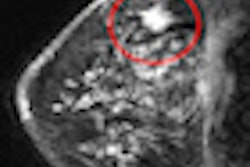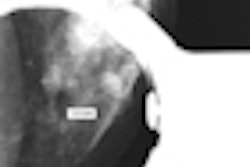Women with breast density of at least 75% on a mammogram have a four to five times greater risk of breast cancer than women with little or no density, making breast tissue density a strong indicator for cancer risk, according to research presented at the American Association for Cancer Research (AACR) annual meeting in Washington, DC.
A group from the Mayo Clinic in Rochester, MN, found that women who had a reduction of at least one density category over a six-year period had a 28% lower risk of developing breast cancer compared to those whose density remained unchanged. The study included more than 19,000 women who had a mammogram at the clinic between 2003 and 2006, according to Celine Vachon, Ph.D., of the Mayo Clinic College of Medicine.
"A decrease in breast density appears to be associated with a lower breast cancer risk, and, importantly, this result takes into account baseline breast density, as well as changes in [body mass index (BMI)] that occurred between mammographic assessments," Vachon said.
The Mayo Clinic research was one of several new studies in mammographic density highlighted this week at the AACR annual meeting.
In other findings, Celia Byrne, Ph.D., of the Lombardi Comprehensive Cancer Center at Georgetown University in Washington, DC, discussed how changes in mammographic density may prove a useful, immediate marker to explain increased breast cancer risk among postmenopausal women using estrogen and progestin therapy (EPT).
Using data from the Women's Health Initiative, Byrne and colleagues evaluated baseline and one-year follow-up mammograms from 97 women who developed invasive breast cancer in the EPT group and 77 women in a placebo group, as well as mammograms from a random sample of 733 healthy controls from both the EPT and placebo groups.
Fifty-seven percent of women in the placebo group had a decline in mammographic density, compared with 16% of women in the EPT group, Byrne said. Forty-seven percent of the women in the placebo group had a modest increase in breast density, while 85% of women in the EPT group had an increase in breast density.
Baseline and change in mammographic density was associated with breast cancer risk in the EPT group, according to Byrne: By comparing breast density from the first and second mammogram, she and her colleagues could predict the women who would be at increased risk of developing breast cancer.
"Baseline breast density needs to be incorporated more in thinking about breast cancer risk," Byrne said. "We need to better understand patients who aren't on estrogen and progestin therapy and what makes some women's breast density decline and others' stay high."
Finally, Dr. Gertraud Maskarinec, Ph.D., of the Cancer Research Center of Hawaii in Honolulu, presented study results indicating that dual-energy x-ray absorptiometry (DEXA) is a low-radiation option to evaluate breast density for women who do not undergo mammography.
Maskarinec's team compared breast density measured by DEXA to breast density measured by mammography among 101 women ages 30 years or older with a normal mammogram. The team found that the DEXA and mammographic measures showed high correlation between the left and right breasts, and common risk factors showed similar patterns for both measurements.
The finding could prove helpful for evaluating breast cancer risk in younger women, for whom having mammograms from an early age could lead to radiation overexposure, according to Maskarinec.
"[DEXA has potential] for use as a new tool for breast cancer prevention among adolescents and young women," Maskarinec said.
By Kate Madden Yee
AuntMinnie.com staff writer
April 21, 2010
Related Reading
Exercise slows decline in mammographic breast density, April 16, 2010
Breast cancer risk assessment starts with the right questions, March 23, 2010
Genetic link between breast density and cancer, February 17, 2010
Women with dense breasts have higher risk of recurring cancer, November 9, 2009
Study: MRI measures breast density in mother-daughter pairs, April 29, 2009
Copyright © 2010 AuntMinnie.com




















